HTC One S Review - International and T-Mobile
by Brian Klug on July 17, 2012 9:30 AM ESTWe’ve already seen 1.5 GHz dual core Krait (MSM8960/MSM8260A/MSM8660A) performance before and talked about it in the HTC One X (AT&T) review, and the USA SGS3 review. For the most part, what we see with the HTC One S variants is largely the same as what we saw with a number of other dual core Krait based devices. Recall that MSM8960, MSM8660A, and MSM8260A differ only in baseband and thus what air interfaces are supported. The only big difference between the devices we've seen based on that SoC so far is RAM, and again the HTC One S includes 1 GB of LPDDR2.
If you’re looking for a detailed comparison to the International SGS3 with Exynos 4412, I've finally had a chance to play with one and we will be doing a more direct comparison with Tegra 3, Exynos 4412, and dual core Krait shortly. I've tossed in the numbers from the International SGS3 for comparison already.
For now, however, let's talk about the HTC One S.
JavaScript Performance
Measuring JavaScript performance is just one component of overall web browsing performance, but it’s the most mature in terms of something we can benchmark. Sunspider 0.9.1 is quite possibly the most well known of these JavaScript tests, and a regular staple of our testing suite:
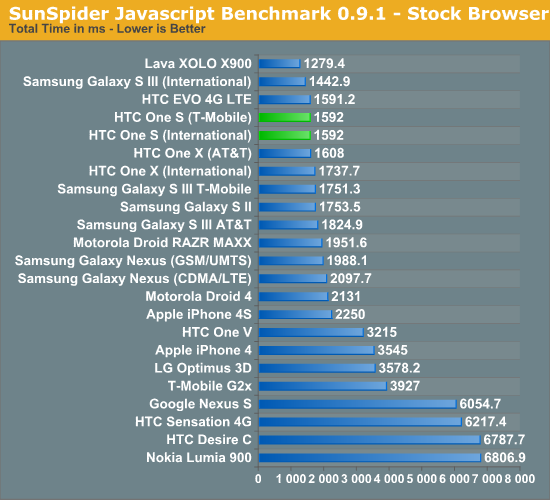
There's an obvious grouping of 1.5 GHz dual core Krait devices around 1500 ms. What spread there is between devices is primarily a function of whatever tweaks OEMs have made to the stock browser's V8 JavaScript engine.
Next up is Browsermark, which is another primarily JavaScript benchmark, with a few other measures. I'm told there are future versions planned which target HTML5 canvas performance.
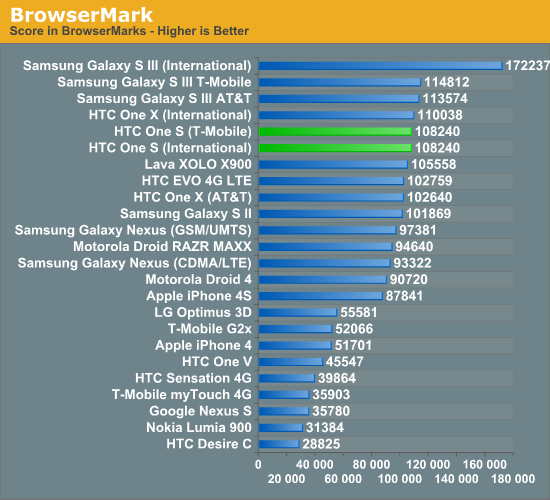
Again there's an obvious clump of dual core Krait devices. The International SGS3 pulls way ahead here for some reason.
Next up is Vellamo, which is a Qualcomm benchmark developed originally for OEMs to use and optimize their browser performance with, and later released for general use. It’s a regular member of our test suite and includes both JavaScript tests and scrolling tests that stress the display composition and hardware acceleration in an Android WebView.
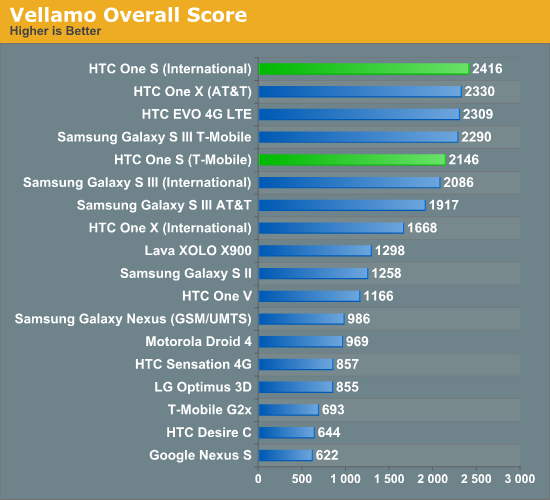
Unsurprisingly the Qualcomm based devices do well in their own benchmark. All of the devices that score above 2000 feel very smooth browsing around in the stock browser and WebView. For the most part, choppy translation and zoom is a thing of the past on Android 4.x.
Low Level FP Performance
Linpack isn’t a great indication of overall smartphone performance, but it is a good test of the floating point capabilities of the CPUs in these SoCs. ARM has steadily been improving FP performance for the past few generations but we’re going to see a big jump to Krait/A15. As most client smartphone workloads are integer based and those that are FP heavy end up relying on the GPU, an advantage here doesn’t tell us much today (particularly because Linpack isn’t running native code but rather atop Dalvik) other than how speedy the FPUs are. There’s a new port of Linpack which runs using native code which we’ll be trying out in the big performance comparison piece.
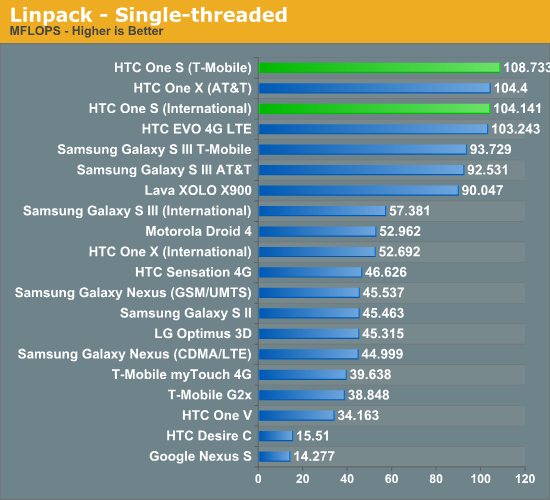
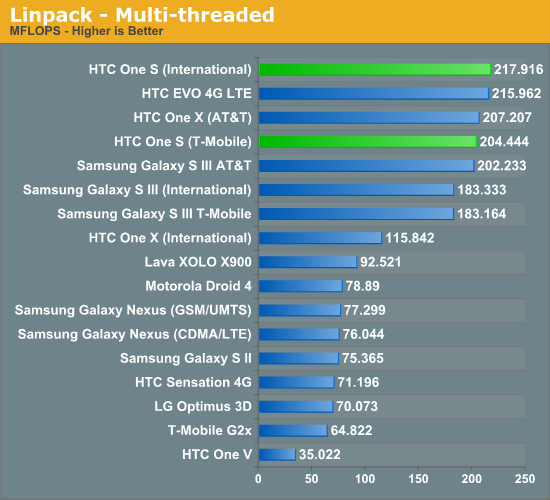
I'm becoming more and more dissatisfied with this GreeneComputing build of Linpack, and given the availability of some alternatives which are implemented natively as opposed to atop Dalvik, will probably move away from it very soon.
BaseMark OS
Rightware’s BaseMark OS is a general purpose benchmark designed to better simulate overall Android performance. It includes a heavily threaded benchmark, file IO tests, and compression/decompression tasks that all contribute to its overall score. This benchmark is pretty much the closest thing we have to a system benchmark for Android at this point, and is very close to achieving the same level of adoption that a few other big industry benchmarks have.
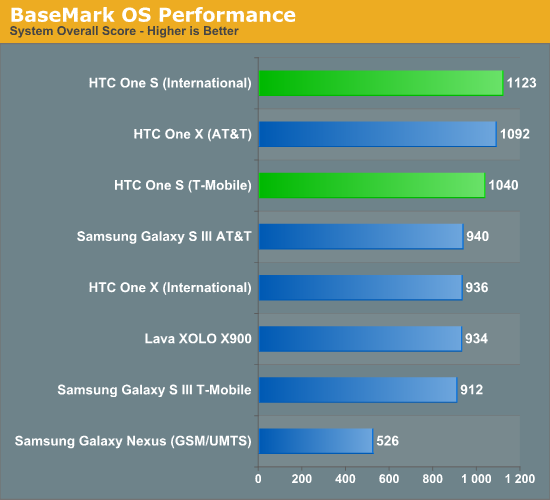
GPU Performance - GLBenchmark 2.1
As we wait for actual 3D gaming benchmarks to make their way into Android (and hopefully cross platform) games, we must rely on synthetic tests designed to simulate 3D game performance as best as possible. We start with GLBenchmark, one of the better Android GPU tests on the market today. There are two benchmarks, Egypt and Pro, and each is run in two modes: native screen resolution and offscreen (vsync disabled) at 720p. The latter is more useful for apples to apples comparisons as everything is rendering the same number of pixels, whereas performance in the onscreen tests is determined by the screen resolution of the device along with the performance of its GPU.
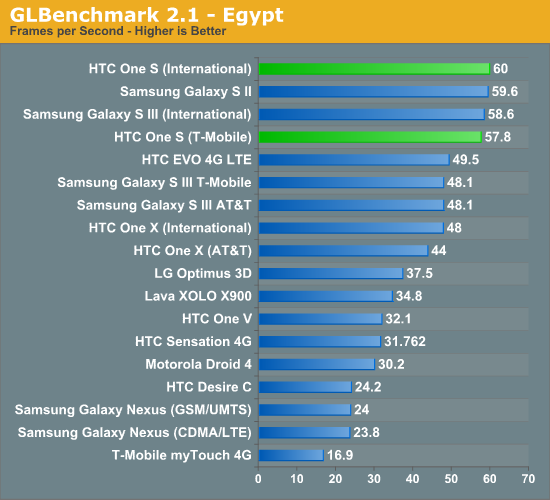
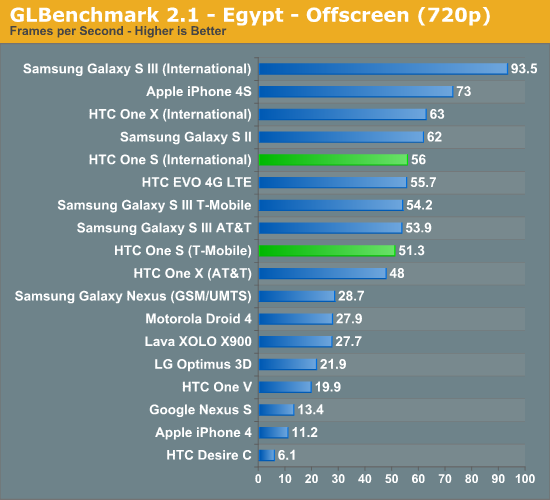
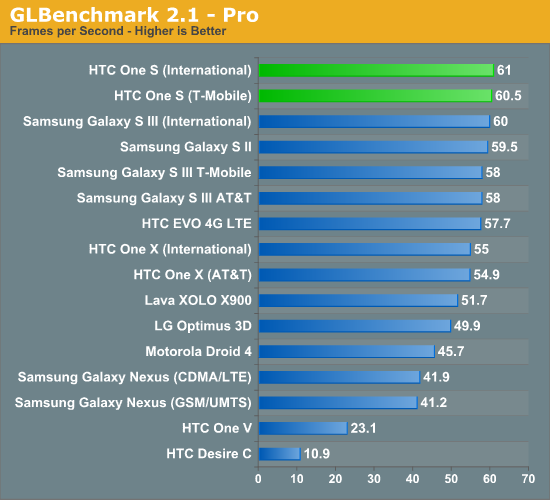
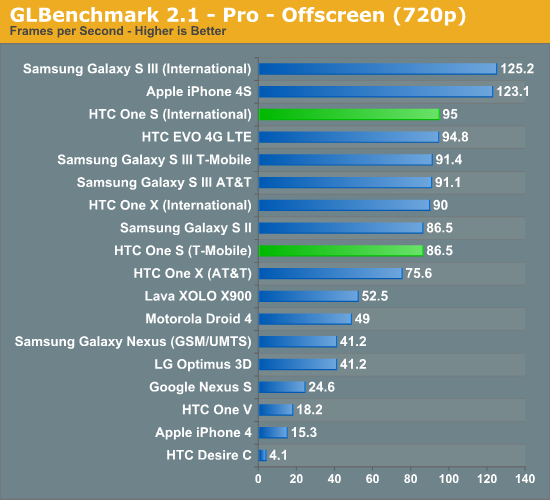
As a reminder, only the offscreen tests take place with vsync turned off, which is why you see devices with 720p displays posting different results on versus off screen where vsync is off. Part of the deal in getting Krait to market as quickly as possible required that Qualcomm pair the CPU with an older GPU, in this case the Adreno 225 instead of the newer Adreno 3xx offerings due out later this year in SoCs like MSM8960 Pro or the quad core Krait APQ8064. As a result, you can see the SGS2 with Exynos 4210 and the SGX543MP2 in the iPhone 4S pull ahead in some tests. Obviously the on-screen test isn’t a totally fair comparison because of the inherent difference in resolution - the One S is qHD.
Basemark ES 2.0 V1
Rightware’s Basemark ES 2.0 V1 is an aging GPU test that tends to favor Qualcomm’s Adreno GPUs above almost all others:
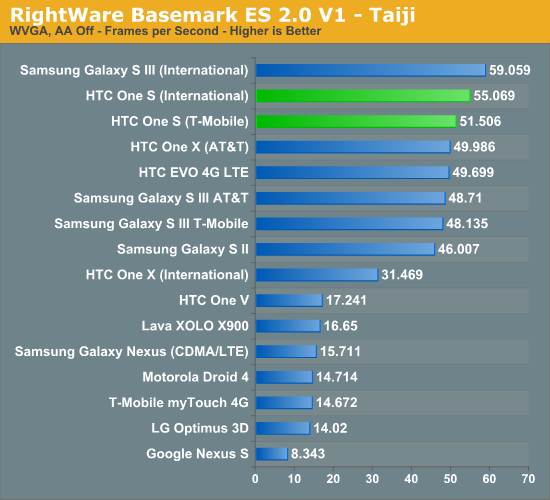
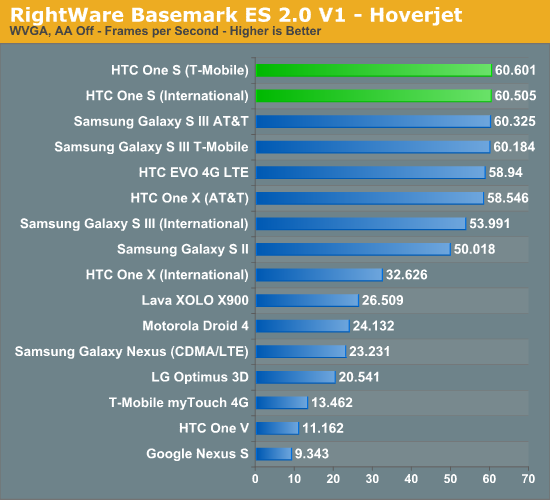
These two tests we run at WVGA on the device. Basemark ES 2.0 is definitely starting to show its age, as Hoverjet is at vsync essentially the whole time, and Taiji is nearly there as well. Qualcomm appears to be using ES 2.0 as an optimization target, so I wouldn’t put too much faith in the ES 2.0 results.










97 Comments
View All Comments
Brian Klug - Tuesday, July 17, 2012 - link
I have to admit I didn't try WiFI Calling, partly because on my prepaid plan WiFi calling is unsupported. I haven't had issues with WiFi in general, but then again WiFi calling does require a different QoS to be pleasant than the typical web browsing use case I stress on WiFi.-Brian
millerduck - Wednesday, July 18, 2012 - link
Thanks for the reply Brian.I have exchanged this phone once and have also been pushed the OTA update without any change in performance. I am hoping another update may be in the works to resolve the issues.
WiFi itself does seem to work fine. If there is a way to add WiFi calling tests to these reviews that would be very helpful as it is a huge selling point on the T-Mobile network.
MD
Zoomer - Thursday, July 19, 2012 - link
What does WiFi calling have to do with the carrier?It's just data to your favorite sip provider, no?
BoloMKXXVIII - Tuesday, July 17, 2012 - link
I find the trend of omiting a microSD card slot disturbing. I have about 8 months left on my current contract and I am hoping there are some quality phones left that still have a microSD card slot by the time I am ready to replace my current phone (HTC Inspire 4G).Johnmcl7 - Wednesday, July 18, 2012 - link
I very much agree and I'm baffled as to why reviewers seem ok with it, I think it's a bit of a joke to have a very powerful phone capable of HD video recording, HD screen and capable of increasingly fancy games with a measly 16GB of a memory and no expansion. I thought it was poor that the slot was removed on the Galaxy Nexus but assumed it would get hammered for it in reviews so no-one else would follow suit but that slipped past and now HTC are at it which again seems fine in this review - I view it as a big plus that the S3 still has micro SD yet that doesn't even get a mention in the verdict. What is the point of having all this fancy hardware if it's crippled by a lack of memory? 16GB is really nothing by the time you've loaded a few games, HD films, music and started taking advantage of the HD recording. Yes you can stream data but data caps seem to be getting increasingly tight at the moment, you need decent reception and it uses considerably more batterypower plus a device with a micro SD card slot can do all that as well if needed.The S3 keeping its micro SD slot is a good sign and I hope that's the way Samsung stay despite others removing the micro SD slot. I also hope they keep the removable battery as that's also something I find increasingly handy, my phone's battery life is pretty good on idle but games and web browsing quickly hammer it but I don't need to worry about that because if I kill the battery I can swap it straight over to a fully charged one without issue rather than the fiddle of trying to charge it on the move with a portable battery charger.
John
OCedHrt - Tuesday, July 17, 2012 - link
The One S's stock browser has an inverted browsing mode - however things I've read on forums (XDA etc) seem to indicate this doesn't really improve battery life.JFish222 - Tuesday, July 17, 2012 - link
I, like so many, am trying to decide between the S3 vs One/Evo/etc (I'm on Sprint.)I prefer the HTC's in hand feel but am looking for other ways to differentiate (that damn 2GB of RAM on the S3 makes it so much hard to go w/ the HTC!)
Can you please include the S3's in the speaker volume tests?
Great Article!
Impulses - Wednesday, July 18, 2012 - link
2GB RAM on the SGS3 and a removable batteryVs
Physical camera button, kickstand, and a slightly better display on the EVO LTE
I opted for the latter because I prefer Sense over Touchwiz and I rarely used the extra batteries I had in the past (with both previous flagship EVOs), they were nice to have when traveling but an external USB battery pack has it's own advantages (no rebooting to slap the battery in) and works well for traveling purposes (throw phone in bag and let it charge while I sleep/move between gates).
The kickstand and camera button are just things I'll get much more use out of. Had the Sprint SGS3 bring able to roam globally like Verizon's version I might've gone the other way tho.
This might be my first two year phone in a while I think, barring any uptick in my travel plans. :p (or a massive failure on Sprint's part to stick to their Network Vision & LTE deployment schedule in Puerto Rico)
TareX - Tuesday, July 17, 2012 - link
Also, AMOLED consumes close to twice more power when displaying the predominantly white screen of web browsers compared to LCDs.Mumrik - Tuesday, July 17, 2012 - link
We're calling 4.3" device diminutive now?What the hell? Let's get real - that's a pretty massive phone. 4" is already biggish.